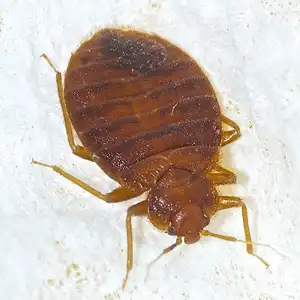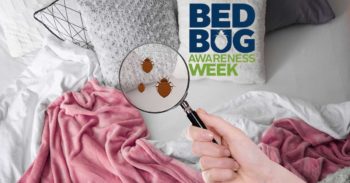
Bed bugs do not hop, skip or jump. They don’t have wings so they cannot fly. However, bed bugs are really good at crawling and hitching rides on clothing, furniture and other items. In fact, that’s one way a bed bug infestation begins. One female bed bug is introduced and deposits eggs in the environment can result in having 400-600 offspring in a few months.
Bed bugs are lazy; they don’t like to move around once they have found an environment that provides all the things that bed bugs need; food, harborage (shelter) and a comfortable temperature range.
Bed bugs feed exclusively on blood. They need a host for feeding. Harborages are any crack or crevice that a bed bug can crawl into. In terms of temperature, bed bugs do very well at temperatures humans feel comfortable; typically, temperatures between 50 and 90 degrees F. As temperatures climb above 90 degrees F., bed bugs become stressed. In fact, at 119 degrees F. bed bugs begin to die-off. Bed bugs are much more tolerant to lower temperatures. Bed bugs have been found outdoors where the temperatures have dropped below 32 degrees F and they appear to be dead. When carried indoors, however, they warm-up and return to normal function.
Bed bugs will stay in their harborages if they have access to a host (blood meal) every 4-5 days and the environment is at room temperature; 55-78 degrees F. Clearly, there are situations that cause bed bugs to move such as changes in available harborage sites, access to a host and temperature fluctuations.
Research has indicated bed bugs will travel from their harborage site to a host and back again. The distance traveled in a 24 hour period may be as much as 40 to 50 feet or more back and forth from the host to harborage.
If the environmental requirements change, the bed bug will try to adapt and stay put. However, bed bugs will migrate from room to room and from apartment to apartment to find a suitable environment.
When a bed bug is first introduced into a home, it may crawl around for days until it locates the right “circumstances”. Bed bugs prefer to hide close to where they feed, but if necessary will crawl several feet to obtain a meal. Initially the bugs tend to be situated around sleeping areas, i.e., beds, couches and recliners. If infestations are allowed to persist, they also may disperse to other locations within the dwelling making elimination more difficult.
Do you need help with bed bugs? Arrow Exterminating Company offers fast and effective bed bug removal services in Long Island, NYC and the 5 Boroughs. Call 516-593-7770 now to speak with our pest experts.






